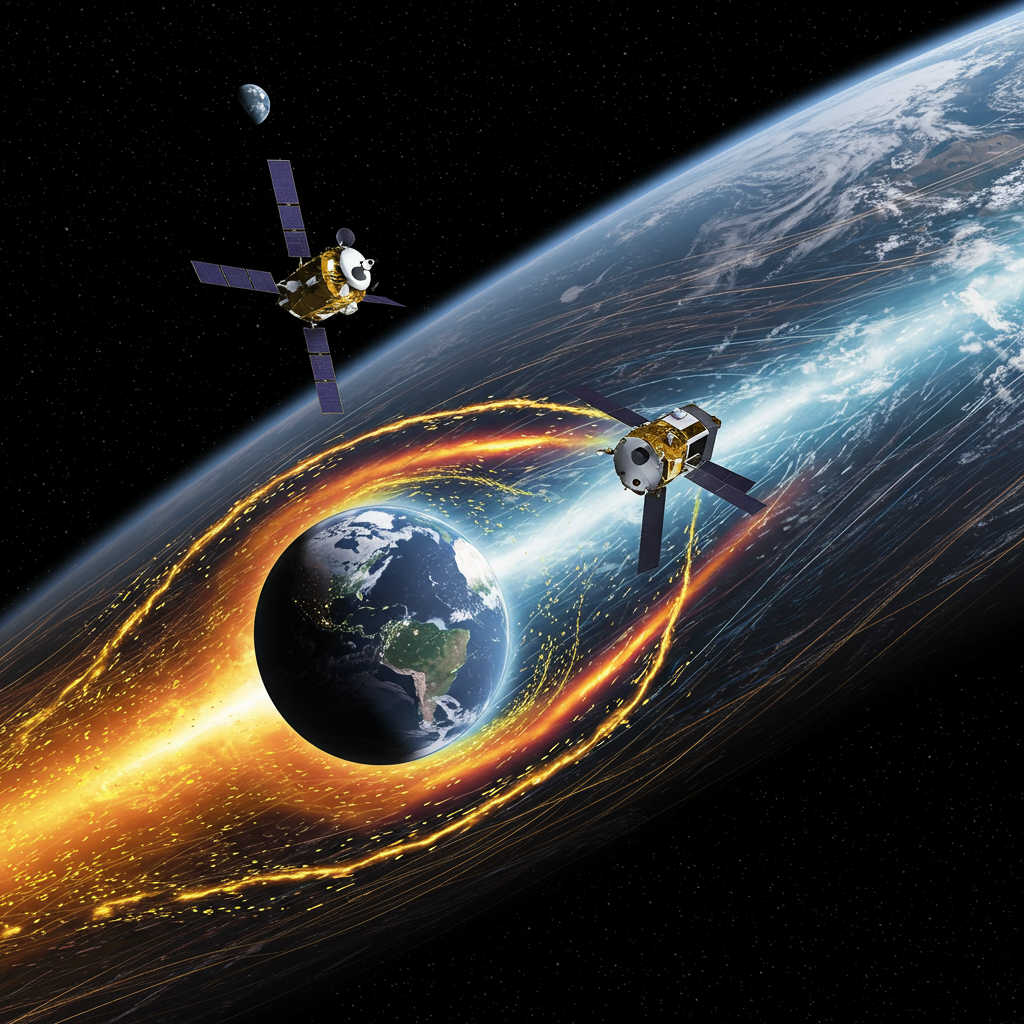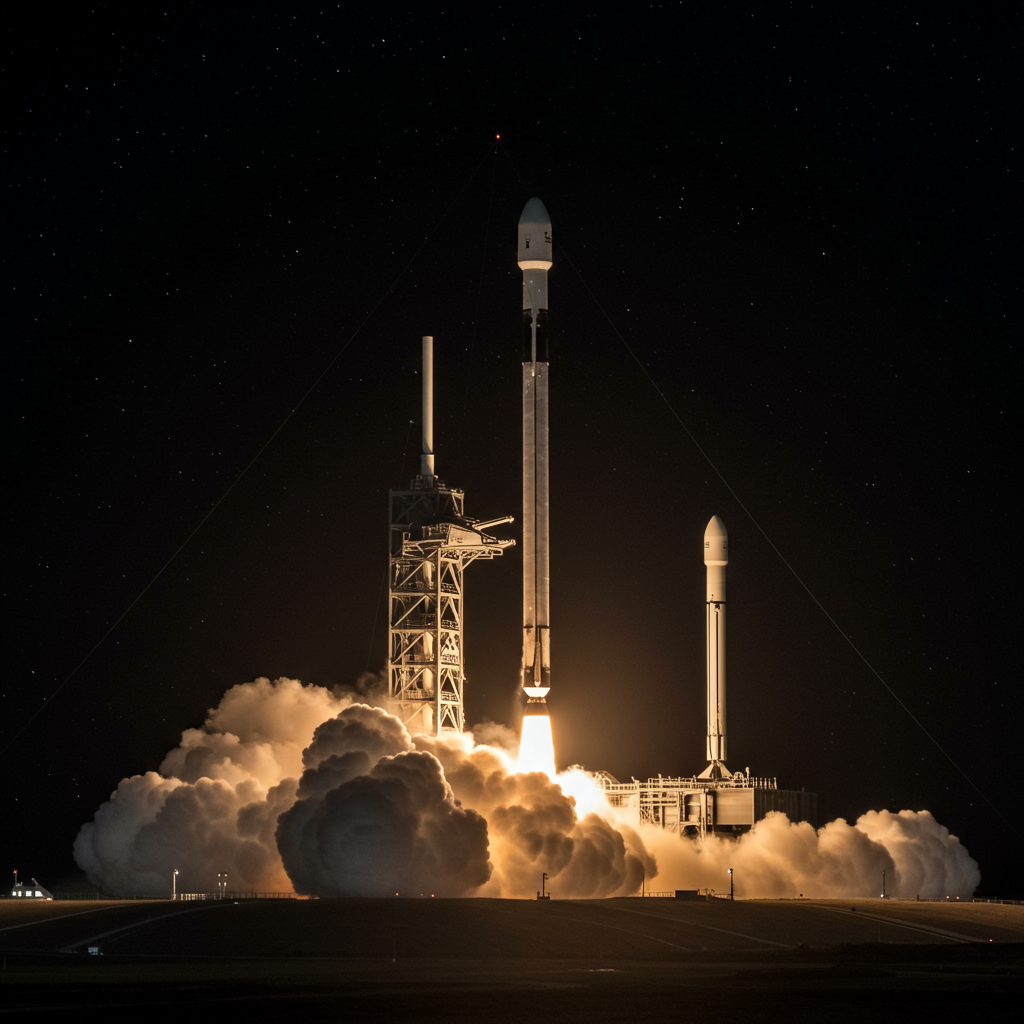The invisible forces shaping our planet’s destiny just got a new pair of eyes in space. On July 23, 2025, NASA launched its groundbreaking TRACERS mission, sending twin spacecraft into orbit to unravel the mysteries of Earth’s magnetic shield and its dynamic interplay with the Sun. This ambitious endeavor promises to deliver critical insights into space weather, safeguarding our technological infrastructure and paving the way for future human exploration beyond Earth.
Protecting Our Planet: The Urgency of Space Weather Research
Imagine a world where GPS signals fail, power grids blackout, and satellite communications cease. These aren’t scenes from a sci-fi movie; they are potential consequences of severe space weather events. Earth is constantly bombarded by the solar wind, a stream of charged particles emanating from the Sun. While our planet’s magnetic field, or magnetosphere, typically acts as a protective shield, the interaction isn’t always benign. Sometimes, this interaction can lead to powerful geomagnetic storms, posing a significant threat to our increasingly space-dependent civilization.
Understanding these complex solar-terrestrial connections is more vital than ever. Disruptions can affect everything from aircraft communications and navigation to the safety of astronauts in orbit. The TRACERS mission is a testament to NASA’s commitment to enhancing our knowledge of heliophysics – the study of the Sun and its influence throughout the solar system – and developing strategies to mitigate these risks. Acting NASA Administrator Sean Duffy underscored this mission’s role in expanding American preeminence in space science and research, with expected breakthroughs supporting future human exploration to the Moon and Mars.
Meet TRACERS: Twin Eyes on Magnetic Reconnection
TRACERS, short for Tandem Reconnection and Cusp Electrodynamics Reconnaissance Satellites, is specifically designed to study a critical process called magnetic reconnection. This explosive phenomenon occurs when magnetic field lines snap and explosively realign, releasing immense amounts of energy and flinging high-speed particles. It’s a fundamental process throughout the universe, but its precise mechanisms and effects on Earth’s magnetosphere remain key scientific questions.
The mission employs two identical spacecraft, built by Millennium Space Systems and proposed by the University of Iowa. These twin satellites, designated T1 and T2, will fly in an incredibly close formation, at times as little as 10 seconds apart over the same location. This unique tandem configuration is crucial. It allows scientists to take a record-breaking 3,000 measurements within a single year, building a detailed, step-by-step picture of how magnetic reconnection evolves over time. By capturing these rapid changes, TRACERS aims to resolve long-standing questions about where and how this energy transfer occurs.
Orbiting the Cusp: A Gateway for Solar Energy
The TRACERS satellites will operate in a 590-kilometer circular Sun-synchronous orbit, specifically targeting Earth’s polar cusps. These “cusps” are funnel-shaped regions near the North and South Poles where Earth’s magnetic field lines are “open,” acting as conduits. Here, the Sun’s magnetic field, carried by the solar wind, can directly collide with Earth’s magnetic field, allowing solar particles to funnel through and interact with atmospheric gases.
Flying directly through these critical regions allows TRACERS to measure the charged particles that race down into Earth’s atmosphere. This data will enable scientists to reconstruct how changes in the incoming solar wind affect the coupling of energy and particles into near-Earth space. David Miles, the TRACERS principal investigator at the University of Iowa, expressed immense excitement, stating the mission is “set to transform our understanding of Earth’s magnetosphere” and “explore the dynamic processes driving space weather.” The insights gained from TRACERS will significantly enhance NASA’s ability to forecast and prepare for space weather events, helping to safeguard humanity’s home in space, as emphasized by Joe Westlake, NASA’s heliophysics division director.
A Multifaceted Launch: Beyond TRACERS
The TRACERS mission wasn’t alone on its journey to orbit. Aboard the SpaceX Falcon 9 rocket from Space Launch Complex 4 East (SLC-4E) at Vandenberg Space Force Base in California, five other small satellites rode along, each with distinct technological demonstration and scientific data collection goals. This rideshare approach showcases innovative strategies for maximizing launch capabilities and advancing multiple space science objectives simultaneously.
Three of these co-passengers were NASA-funded missions:
Athena EPIC (Economical Payload Integration Cost): This pathfinder mission demonstrates an innovative, configurable commercial SmallSat architecture. It aims to improve payload design flexibility, reduce launch schedules, and cut costs for future missions. A collaborative effort involving NASA’s Langley Research Center, NOAA, U.S. Space Force, and NovaWurks, Athena EPIC will also measure outgoing longwave radiation from Earth after its commissioning phase.
PExT (Polylingual Experimental Terminal): Managed by NASA’s Space Communications and Navigation (SCaN) program, PExT is designed to test the interoperability between commercial and government communication networks. Equipped with software-defined radios, it will demonstrate the ability to seamlessly switch between different networks in low Earth orbit, much like a cell phone roaming between providers. This technology is crucial for NASA’s transition to a commercial satellite relay architecture.
- REAL (Relativistic Electron Atmospheric Loss): A CubeSat mission led by Dartmouth College, REAL investigates how energetic electrons are scattered out of the Van Allen radiation belts and into Earth’s atmosphere. These “killer electrons” pose a threat to spacecraft and astronauts. Understanding their behavior is critical for improving space safety and could lead to new ways to mitigate their effects. Robyn Millan, REAL’s principal investigator, noted its unique, powerful particle sensor.
- www.nasa.gov
- spaceflightnow.com
- www.nasaspaceflight.com
- in.mashable.com
- www.press-citizen.com
Additionally, the Falcon 9 carried two commercial rideshare payloads: the LIDE transponder demonstrator by Tyvak and an Australian Skykraft spacecraft, which will augment a constellation for global air-traffic management.
The Launch Journey: A Smooth Ascent
The launch itself, originally scheduled a day earlier but delayed due to an unexpected aircraft in the airspace, occurred precisely at 11:13 a.m. PDT (2:13 p.m. EDT) on Wednesday, July 23, 2025. The SpaceX Falcon 9, specifically booster B1081 on its 16th flight (which previously supported notable NASA missions like Crew-7, PACE, and EarthCARE), executed a flawless ascent. The reusable first stage successfully performed a return-to-launch-site landing at Landing Zone 4 (LZ-4) back near the launch pad, marking another successful recovery for SpaceX.
Ground controllers quickly established communications with the TRACERS spacecraft within hours of deployment. The twin satellites will now undergo a four-week commissioning period. During this time, mission controllers will meticulously check out all instruments and systems. Once cleared, the TRACERS team will commence their 12-month prime mission, eager to begin collecting invaluable data that will redefine our understanding of Earth’s magnetic shield and the dynamic forces of space weather.
Frequently Asked Questions
What is magnetic reconnection and why is TRACERS studying it?
Magnetic reconnection is an explosive cosmic process where magnetic field lines break apart and rapidly reconfigure, releasing massive amounts of energy and accelerating charged particles to high speeds. The TRACERS mission is studying this phenomenon because it’s a primary mechanism by which solar wind energy enters Earth’s magnetosphere. Understanding how magnetic reconnection shapes space weather impacts is critical for predicting and mitigating adverse effects on technologies like satellites, power grids, and GPS systems.
Where do the TRACERS satellites operate, and what makes this region crucial?
The TRACERS satellites orbit in a low-Earth, Sun-synchronous orbit at an altitude of 590 kilometers, specifically targeting Earth’s polar cusps. These cusps, located near the North and South Poles, are unique funnel-shaped regions where Earth’s magnetic field lines are “open.” This allows the solar wind to directly interact with our planet’s magnetic field and atmosphere. By flying through these areas, TRACERS can directly measure the incoming high-energy particles, providing unprecedented data on how solar energy couples into Earth’s space environment.
How will the TRACERS mission benefit daily life and future space endeavors?
The TRACERS mission will significantly enhance our ability to understand, predict, and ultimately mitigate the impacts of space weather. By providing detailed insights into magnetic reconnection and the coupling of solar energy with Earth’s magnetosphere, it will help protect vital infrastructure, including communications satellites, navigation systems (GPS), and terrestrial power grids, all of which are vulnerable to geomagnetic storms. Furthermore, the knowledge gained will be crucial for ensuring the safety of astronauts and spacecraft during future human exploration missions to the Moon and Mars, contributing to American preeminence in space science.
A Future Forged in Space
The launch of NASA’s TRACERS mission marks a pivotal moment in our quest to understand the complex relationship between the Sun and Earth. By delving deep into the mechanics of space weather and the protective dynamics of our magnetic shield, TRACERS will not only advance fundamental science but also provide practical benefits for our increasingly interconnected world. The data gathered by these twin sentinels promises to illuminate pathways for greater resilience against cosmic forces, ensuring a safer and more predictable future in space and on Earth.



